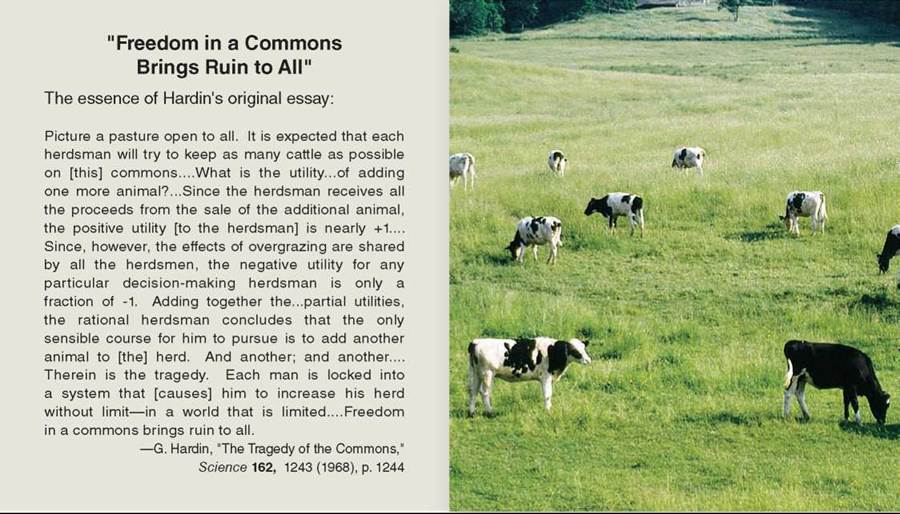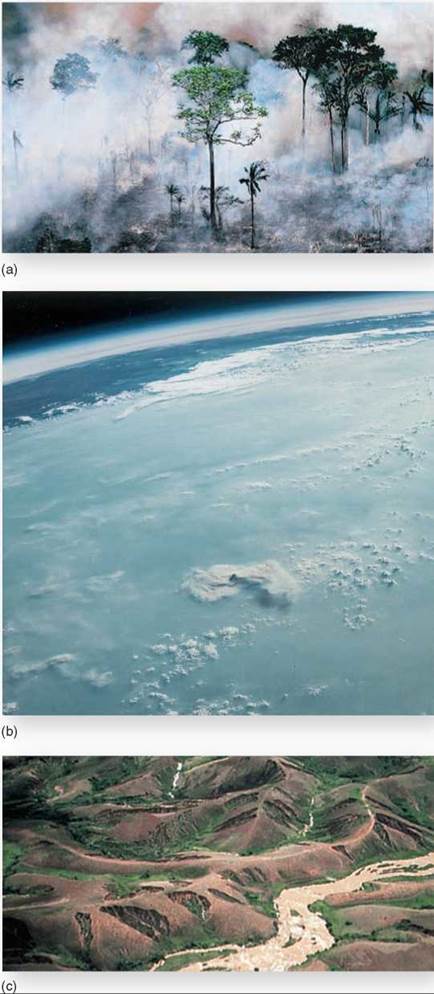THE LIVING WORLD
Unit Eight. The Living Environment
38. Human Influences on the Living World
38.7. Preserving Nonreplaceable Resources
Among the many ways ecosystems are being damaged, one problem stands out as more serious than all the rest: consuming or destroying resources that we all share in common but cannot replace in the future (figure 38.9). Although a polluted stream can be cleaned, no one can restore an extinct species. In the United States, three sorts of nonreplaceable resources are being reduced at alarming rates: topsoil, groundwater, and biodiversity.

Figure 38.9. The tragedy of the commons.
In a now-famous essay, ecologist Garrett Hardin argues that destruction of the environment is driven by freedom without responsibility.
Reprinted with permission from "The Tragedy of the Commons," by G. Hardin, Science, 162, p. 1244. Copyright 1968 AAAS.
Topsoil
Soil is composed of a mixture of rocks and minerals with partially decayed organic matter called humus. Plant growth is strongly affected by soil composition. Minerals like nitrogen and phosphorus are critical to plant growth, and are abundant in humus-rich soils.
The United States is one of the most productive agricultural countries on earth, largely because much of it is covered with particularly fertile soils. Our Midwestern farm belt sits astride what was once a great prairie. The soil of that ecosystem accumulated bit by bit from countless generations of animals and plants until, by the time humans came to plow, the humus-rich soil extended down several feet.
We cannot replace this rich topsoil, the capital upon which our country’s greatness is built, yet we are allowing it to be lost at a rate of centimeters every decade. Our country has lost one- quarter of its topsoil since 1950! By repeatedly tilling (turning the soil over) to eliminate weeds, we permit rain to wash more and more of the topsoil away, into rivers and eventually out to sea. New approaches are desperately needed to lessen the reliance on intensive cultivation. Some possible solutions include using genetic engineering to make crops resistant to weedkilling herbicides and terracing to recapture lost topsoil.
Groundwater
A second resource that we cannot replace is groundwater, water trapped beneath the soil within porous rock reservoirs called aquifers. This water seeped into its underground reservoir very slowly during the last ice age over 12,000 years ago. We should not waste this treasure, for we cannot replace it.
In most areas of the United States, local governments exert relatively little control over the use of groundwater. As a result, a very large portion is wasted watering lawns, washing cars, and running fountains. A great deal more is inadvertently being polluted by poor disposal of chemical wastes—and once pollution enters the groundwater, there is no effective means of removing it. Some cities, like Phoenix and Las Vegas, may completely deplete their groundwater within several decades.
The number of species in danger of extinction during your lifetime is far greater than the number that became extinct with the dinosaurs. This disastrous loss of biodiversity is important to every one of us, because as these species disappear, so does our chance to learn about them and their possible benefits for ourselves. The fact that our entire supply of food is based on 20 kinds of plants, out of the 250,000 available, should give us pause. Like burning a library without reading the books, we don’t know what it is we waste. All we can be sure of is that we cannot retrieve it. Extinct is forever.
Over the last 20 years, about half of the world’s tropical rain forests have been either burned to make pasture land or cut for timber (figure 38.10). Over 6 million square kilometers have been destroyed. Every year the rate of loss increases as the human population of the tropics grows. About 160,000 square kilometers were cut each year in the 1990s, a rate greater than 0.6 hectares (1.5 acres) per second! At this rate, all the rain forests of the world will be gone in your lifetime. In the process, it is estimated that one-fifth or more of the world’s species of animals and plants will become extinct—more than a million species. This would be an extinction event unparalleled for at least 65 million years, since the Age of Dinosaurs.

Figure 38.10. Tropical rain forest destruction.
(a) These fires are destroying the rain forest in Brazil, which is being cleared for cattle pasture. (b) The flames are so widespread and so high that their smoke can be viewed from space. (c) The consequences of deforestation can be seen on these middle-elevation slopes in Ecuador. The slopes now support only low-grade pastures where they used to support highly productive forest.
You should not be lulled into thinking that loss of biodiversity is a problem limited to the tropics. The ancient forests of the Pacific Northwest are being cut at a ferocious rate today, largely to supply jobs (the lumber is exported), with much of the cost of cutting it down subsidized by our government (the Forest Service builds the necessary access roads, for example). At the current rate, very little will remain in a decade. Nor is the problem restricted to one area. Throughout our country, natural forests are being “clear-cut,” replaced by pure stands of lumber trees planted in rows like so many lines of corn. It is difficult to scold those living in the tropics when we ourselves do such a poor job of preserving our own country’s biodiversity.
But what is so bad about losing species? What is the value of biodiversity? Loss of a species entails three costs: (1) the direct economic value of the products we might have obtained from species; (2) the indirect economic value of benefits produced by species without our consuming them, such as nutrient recycling in ecosystems; and (3) their ethical and aesthetic value. It is not difficult to see the value in protecting species that we use to obtain food, medicine, clothing, energy, and shelter, but other species are vitally important to maintaining healthy ecosystems; by destroying biodiversity, we are creating conditions of instability and lessened productivity. Other species add beauty to the living world, no less crucial because it is hard to set a price upon.
Key Learning Outcome 38.7. Nonreplaceable resources are being consumed at an alarming rate all over the world; key among them are topsoil, groundwater, and biodiversity.